According to many experts, chronic prostatitis is an inflammatory disease caused by an infection with possibly adding autoimmune diseases, characterized by lesions of the parenchymal and interstitial organ.The disease has been known to medicine since 1850, but it is still poorly understood today and difficult to treat.Chronic bacterial prostatitis (6 to 10 %) and non -bacterial (80 to 90 %) are the most common and socially significant inflammatory diseases in men, considerably reducing their quality of life.The disease is recorded mainly in young people and an average age and is often complicated by disorders of copulative and generative functions (reduction in power, infertility, etc.).The disease is recorded in men in 8 to 35 % of cases aged 20 to 40.
The cause of bacterial prostatitis is the pyogenic flora which enters the gland by the urethra or by the lymphogenic and hematogenous ways.The etiology of chronic non -bacterial prostatitis and its pathogenesis remain unknown.It mainly affects men over 50.
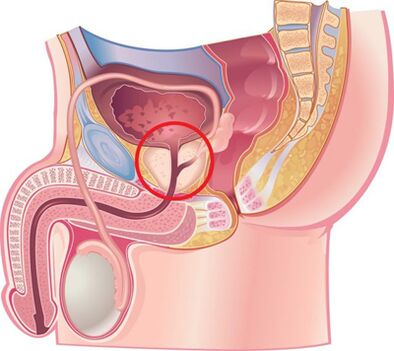
Reasons for the development of the disease
Chronic prostatitis is currently considered a polyetiological disease.There is an opinion that the disease occurs as a result of an infection penetrating into the prostate, then the pathological process takes place without its participation.This is facilitated by a number of non -infectious factors.
Infectious factors for the development of chronic prostatitis
In 90% of cases, pathogens penetrate the urethra iron, as a result of which acute or chronic prostatitis occurs.Cases of asymptomatic carriage are noted.The course of the disease is influenced by the state of the protective forces of the human body and the biological properties of the pathogen.It is assumed that the transition from acute to chronic prostatitis occurs due to loss of tissue elasticity due to excessive fibrous tissue products.
Among the causal agents of chronic prostatitis, the following pathogens are found:
- In 90% of cases, the disease reveals Gram-Negative bacteria such as Escherichia coli (E. coli), Enterococcus faecalis (fecal Enterococcus), a little less often - Pseudomonas aeruginosa, Klebsiella spp., Proteus spp., Prootes spp.Pseudomonas aeruginosa, Enterobacter aerogenes and Acinetobacter spp.Camera-positive enterosococci, streptococci and staphylococci bacteria are rare.
- The role of coagulasis-negative staphylococci, ureaplasma, chlamydia, trichomoniasis, gardnerell, anaerobic bacteria and fungi of the genus Candida was not finally clarified.
Infection in the prostate enters in several ways:
- The ascending path is the most probable which is proven by a frequent combination of prostatitis and urethritis.
- Hematogenous prostatitis develops with the penetration of infection into the gland with blood flow, which is observed with chronic tonsillitis, sinusitis, periodontitis, pneumonia, cholecystitis and cholangitis, purulent skin diseases, etc.
- By contact, chronic prostatitis develops with urethritis and urethral strictures, when the infection enters the gland ascending with the urinary flow, with purulent kidney infections, canalicularly with epipidymitis, deferentitis and funiculitis, during diagnostic and therapeutic urological manipulations (catheterization, bougienage, instillationurethral), including transurethral.
- Lymphogenic, infection enters prostate during rectites, thrombophlebitis of hemorrhoidal veins, etc.

Non-infectious factors in the development of chronic prostatitis
Chemical factors
According to experts, the main role in the development of chronic prostatitis belongs to the intraprostatic urinary reflux, when urine flows from the urethra to the gland, which causes the drain of prostate and seminal vesicles.
During the disease, vascular reactions develop, resulting in swelling of the organ, the nervous and humoral regulation of the tone of the smooth muscle tissue of the urethra is disturbed and the activation of the alpha1-the adrenergic receivers cause the development of dynamic obstruction and contribute to the development of new intraprostatic reflux.
During the reflux, the uras contained in the urine lead to the development of a "chemical inflammatory response".
Hemodynamic disorders
Supports chronic inflammation and circulatory disorders of pelvic organs and scrotum.Congestion is developing in people leading a sedentary life, for example drivers, office employees, etc., with obesity, sexual abstinence, dysmetry of sex life, frequent hypothermia, mental and physical overload.Eat hot and spicy foods, alcohol, smoking, etc.contribute to maintaining the inflammatory process.
Other factors
There are many other factors that promote chronic inflammation of the prostate.These include:
- Hormonal.
- Biochemical.
- Immune response disorders.
- Autoimmune mechanisms.
- Infectious and allergic processes.
- Characteristics of the structure of the prostate, leading to difficulties in adequate drainage.
Very often, the causes of the development of chronic prostatitis cannot be determined.
Prostatitic classification
According to the classification proposed in 1995 by the United States National Institutes of Health, prostatitis is divided into:
- Acute (category I).Amounts to 5 to 10%.
- Chronic bacterial (category II).Amounts to 6 - 10%.
- Chronic non -bacterial inflammation (category IIIA).It is 80 to 90 %.
- Chronic non-bacterial non-inflammatory syndrome (category IIIB) or chronic pelvic pain.
- Chronic prostatitis detected by accident (category IV).
Signs and symptoms of chronic prostatitis
The course of chronic prostatitis is long, but not monotonous.Exacerbation periods are replaced by relative lighter periods that occur after a complete anti-inflammatory and antibacterial treatment.
The development of chronic bacterial prostatitis is often preceded by urethritis of bacterial nature or gonorrhea, non-bacterial circulatory disorders in the pelvic organs and scrotum (hemorrhoids, varicocells, etc.), sexual excesses.
Patients with chronic prostatitis have many complaints.They have been treating doctors for years, but are very rarely examined for prostate disease.About a quarter of patients report no complaints, or the disease proceeds with meager clinical symptoms.
Complaints of patients with chronic prostatitis can be divided conditionally into several groups.
Urination disturbances associated with urethral stricture:
- Difficulties at the start of urination.
- A low urine flow.
- Intermittent or urination has dropped.
- A feeling of incomplete emptying of the bladder.
Symptoms caused by irritation of nerve endings:
- Frequent urination.
- Calls for urination are clear and strong.
- Urination in small portions.
- CONTINUATION OF URINE during the urge to urinate.
Pain syndrome:
- The intensity and nature of the pain are different.
- Localization of pain: Lower abdomen, area of the perineum, rectum, groin and lower back, the inner surface of the hips.
Sexual Function Disorders:
- Pain in the rectum and urethra during ejaculation.
- Slow erection.
- Loss of orgasm.
- Premature ejaculation, etc.
Of the nervous system: neurotic disorders in the form of repair of the attention of patients in the state of their health.
Signs and symptoms of chronic non -bacterial prostatitis
Chronic pelvic pain in men (CFTB) proceeds with the usual symptoms of chronic prostatitis, but in the 3rd part of urine and a secret of the prostate in the study of bacteria are absent.Simulating BTC can simulate chronic nebacterial interstitial cystitis, rectal diseases, spastic pelvic floor myalgia, and a functional prostate caused by impaired innervation of organic organs and its hemodynamics.
In case of impaired neurovegetative function, atony and impaired innervation of the gland are noted, which are manifested by difficulties in rapid and complete closure of the lumen of the urethra.At the same time, urine, after urination, continues to stand out for a long time drops.In these patients, in the study, instability and increased excitability are found, which is manifested by increased sweating and excitability of cardiac activity, changes in the dermographic.
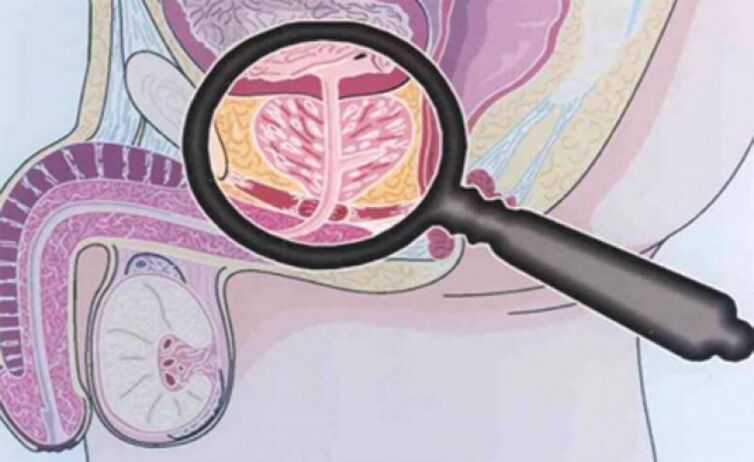
Complications of the disease
The long evolution of chronic prostatitis is complicated by the disorders of sexual and reproductive functions, the development of diseases such as vesiculitis and epipidimitis, as well as the sclerosis of the organ.The sclerosion of the organ aggravates local microcirculation and urodynamics, as well as the results of surgical interventions.The fibrosis of the perihumetral tissues leads to the development of urination disorders.
Diagnosis
Due to the fact that there are many reasons for the development of chronic prostatitis, a whole complex of diagnostic studies is used to diagnose it.The success of treatment depends on the correct determination of the causes of the disease.The diagnosis of chronic prostatitis is based on the following data:
- Classic triad of symptoms.
- A complex of physical methods (rectal examination of the prostate fingers).
- A complex of laboratory methods (urinalysis and prostate microscopy, sowing and determining the sensitivity of microflora to antibacterial drugs, general analysis of urine and blood).
- To detect gonococci, maculte bacterioscopy of the urethra, PCR and serological methods (to detect uablasmes and chlamydia).
- Urofluometry.
- Prostate biopsy.
- A complex of instrumental methods (ultrasound).
- Determination of the patient's immune status.
- Determination of neurological status.
- With the ineffectiveness of treatment and the suspicion of the development of complications, magnetic and magnetic resonance imaging, blood sowing, etc.
Palpation of the prostate gland
Palpation of the prostate, which increases during the period of exacerbation and decreases in the period of the subsidiary of the inflammatory process, is of paramount importance in the diagnosis of the disease.In chronic prostatitis, during the period of exacerbation iron is swollen and painful.
The density of the coherence of the organ may be different: the softening and compacting areas are palpated, the western areas are determined.On palpation, it is possible to assess the form of the gland, the condition of the seed tubers and surrounding tissues.
The process of examining the transrectal fingers is combined with the seizure of the gland.Sometimes it is necessary to obtain a secret from each part separately.
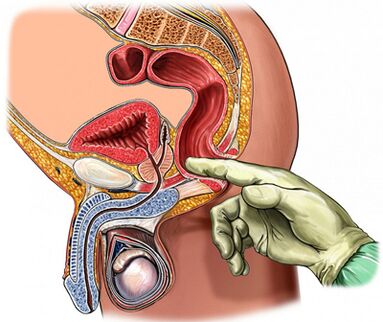
Analysis of 3 glasses of urine and prostate secretion
The gold standard in the diagnosis of chronic prostatitis is:
- Collection of the first part of urine.
- Collection of a second part of urine.
- Obtaining the secret of the gland by massage.
- Collection of the third portion of urine.
Then, a microscopic and bacteriological examination of the material is carried out.
With inflammation of the prostate:
- Microbial count (CFU) exceeds 103/ml (104/ml for epidermal staphylococci), but we must not neglect the small number of microbes, numbering in the tens and hundreds.
- The presence of 10-15 leukocytes in the field of view, identified by microscopy, is a generally accepted criterion for the presence of an inflammatory process.
Prostate secretion and the 3rd portion of urine are subject to a microscopic and bacteriological examination:
- In chronic bacterial prostatitis, there is an increase in the number of leukocytes in the secretion of the gland and in the third part of post-massage urine, and bacteria (mainly of the intestinal group) are released.
- With non-bacterial prostatitis, there is an increase in the number of leukocytes in the secretion of the gland, but the microflora is not detected.
- In CPPS, there is also no increase in the number of leukocytes and microflora.
Normal prostate secretion:
- Less than 10 leukocytes per field of vision.
- There are a large amount of lecithin grains.
- There is no microflora.
In chronic prostatitis, we find in prostatic secretion:
- The number of leukocytes is important - exceeds 10-15 in the field of vision.
- The number of lecithin grains is reduced.
- The pH of secretion moves on the alkaline side.
- Acid phosphatase content is reduced.
- Lysozyme activity is increased.
Obtaining negative results of prostatic secretion does not prove the absence of inflammatory processes.
The interest in the prostatic secretion crystallization test remains.Normally, upon crystallization, a characteristic fern leaf-shaped pattern is formed.In case of violation of the aggregative properties of prostatic secretion, such a pattern is not formed, which occurs when the androgenic hormonal background changes.
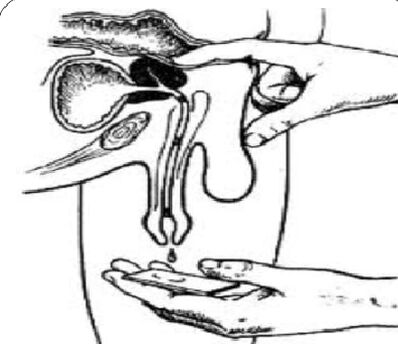
Ultrasound
If prostate disease is suspected, ultrasound of the gland itself (transrectal ultrasound), kidneys and bladder is optimal, which makes it possible to determine:
- Volume and size of the gland.
- Presence of stones.
- Seminal vesicle sizes.
- Condition of the bladder walls.
- Amount of residual urine.
- Structures of the scrotum.
- Another type of pathology.
Other prostate examination methods
- The state of urodynamics (the study of urinary flow) is easily and simply determined using a study such as urinary flowmetry.Thanks to this study, it is possible to quickly detect signs of obstruction when the bladder is released and to carry out dynamic surveillance.
- A puncture biopsy is carried out if the formation of an abscess, benign hyperplasia and prostate cancer are suspected.
- In order to clarify the reasons for the development of infraveicular obstruction, radiographic and endoscopic examinations are carried out.
- In case of prolonged inflammatory process, it is recommended to perform urethrocystoscopy.
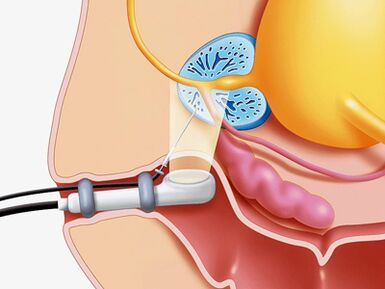
Differential diagnosis
Chronic prostatitis should be distinguished from vesiculoprostatostasis, vegetative prostatopathy, congestive prostatitis, pelvic floor myalgia, neuropsychiatric disorders, pseudodyssynergia, reflex sympathetic dystrophy, inflammatory diseases of other organs: interstitial cystitis,osteitis of the pubic symphysis, sexual diseases.dysfunction, bladder neck hypertrophy, urethral stenosis, tuberculosis, prostate and bladder cancer, urolithiasis, chronic epipidymitis, inguinal hernia.
Treatment of chronic prostatitis
Treatment of chronic prostatitis should begin with changes in the patient's lifestyle and diet.
When treating the disease, drugs that affect different parts of the pathogenesis are used simultaneously.
Main therapeutic orientations:
- Elimination of responsible micro-organisms.
- Anti-inflammatory therapy.
- Normalization of blood circulation in prostate and pelvic organs.
- Normalization of adequate drainage of prostatic acini.
- Normalization of the hormonal profile.
- Prevention of organ sclerosis.
For the treatment of chronic prostatitis, the following groups of drugs are used:
- Antibacterial.
- Anticholinergic.
- Vasodilators.
- Alpha1- Adrenergic blockers.
- 5 alpha reductase inhibitors.
- Cytokine inhibitors.
- Non-steroidal anti-inflammatory drugs.
- Angioprotectors.
- Immunomodulators.
- Drugs affecting the metabolism of the urate.
Antibiotics in the treatment of chronic bacterial prostatitis
Antibiotic therapy should be carried out taking into account the sensitivity of the identified microorganisms to antibiotics.If the pathogen is not identified, empirical antimicrobial therapy is used.
The drugs of choice are 2nd to 4th generation fluoroquinolones.They quickly penetrate into glandular tissue with conventional application methods and are active against a large group of Gram-negative microorganisms, as well as against ureaplasma and chlamydia.If antimicrobial treatment fails, the following should be considered:
- multi-resistance of microflora,
- short cures (less than 4 weeks),
- incorrect choice of antibiotic and its dosage,
- changes in the type of pathogen,
- The presence of bacteria living in prostatic canals, covered with a protective extracellular membrane.
The duration of treatment should be at least 4 weeks with obligatory subsequent bacteriological control.If bacteriuria persists in the 3rd portion of urine and prostatic secretion for more than 103UFC/ML, a new antibiotic therapy is prescribed for a period of 2 to 4 weeks.
Cytokine inhibitors in the treatment of chronic prostatitis
Cytokines are glycoproteins secreted by immune and other cells during inflammatory and immune response conditions.They actively participate in the development of the chronic inflammatory process.
Non-steroidal anti-inflammatory drugs
Non-steroidal anti-inflammatory drugs have an anti-inflammatory effect and reduce pain and fever.Widely used in the treatment of chronic prostatitis in the form of tablets and suppositories.The most effective route of administration is rectal.
Immunotherapy
In the treatment of chronic bacterial prostatitis, in addition to antibiotics and anti-inflammatory drugs, immunomodulatory agents are used.The rectal route of administration is the most effective.An immunomodulator is widely used, increasing the functional activity of phagocytes, which contributes to more effective elimination of pathogens.
Alpha-blockers in the treatment of chronic prostatitis
It has been established that alpha-1 adrenergic blockers normalize the tone of the smooth muscles of the prostate urethra, seminal vesicles and prostatic capsule, which makes drugs of this group very effective in the treatment of the disease.Alpha-1 adrenergic blockers are used in patients with severe urination disorders in the absence of active inflammatory processes.
For CPPS, the duration of treatment varies from 1 to 6 months.
5A-Reductase inhibitor in the treatment of abacterial prostatitis and CPPS
It has been established that under the influence of the 5A-Reductase enzyme, testosterone is transformed into a 5A-Dihydrotetosterone prostate form, whose activity in prostate cells is more than 5 times greater than the activity of testosterone itself, which in the elderly leads to hypertrophy of the organ due to epithelial components and stromos.
When taking a 5A-Reductase inhibitor, there is an atrophy of the stromal fabric for 3 months, atrophy of the glandular fabric for 6 months, the secretory function is inhibited, the intensity of the pain and the volume of the gland are reduced, the tension and the swelling of the organ are reduced.
The role of anti -Clerotic drugs in the treatment of chronic prostatitis
With prolonged inflammation of the prostate, fibrosis develops, which is manifested by disturbances in microcirculation and urodynamics.To prevent the fibrosis process, antisclerotic drugs are used.
Other drugs used in the treatment of chronic prostatitis
In addition to the medications described above, the following are used to treat the condition:
- Antihistamines.
- Vasodilators and angioprotectors.
- Immunosuppressants.
- Drugs that affect urate metabolism and trisodic citric acid.
Plant -based products
Effective in the treatment of prostatitis, the use of the drug in the form of candles containing a complex of biologically active peptides isolated from the prostatic gland of cattle.
Under the influence of the drug,:
- Stimulation of metabolic processes in gland tissues.
- Improved microcirculation.
- Reduction of edema, infiltration, stagnation and pain of leukocytes.
- Prevention of thrombosis in the veins of the prostate gland.
- Increased activity of the acin secretory epithelium.
- Improved sexual function (increased libido, restoration of erectile function and normalization of spermatogenesis).
Fingers massage of the prostate gland
A number of researchers say that in chronic prostatitis, finger massage should be used, taking into account known contraindications.
Physiotherapy
The effectiveness of physiotherapeutic procedures in the treatment of prostatitis is not proven today, the mechanism of action has not been scientifically established, the undesirable effects have not been studied.
Prevention of chronic prostatitis
Beginning the prevention of the development of chronic prostatitis, you must know:
- The risk of developing the disease has increased over the years.
- Representatives of the Negroid race are more predisposed to the disease.
- A family predisposition to the disease is not excluded.
People with predisposition to the development of chronic prostatitis should be more attentive to their state of health.
Tips to prevent illness:
- Take enough fluids.Frequent urination helps eliminate microflora from the urethra.
- Prevent diarrhea and constipation.
- Respect a balanced diet.Avoid eating foods rich in carbohydrates and saturated fats, which cause weight gain.
- You should limit the consumption of substances that irritate the urethra as much as possible: hot and spicy foods, smoked foods, sauces and seasonings, coffee and alcohol.
- Stop smoking.Nicotine negatively affects the state of the vascular walls.
- Don't be too cold.
- Don't hesitate to empty your bladder.
- Lead an active lifestyle and play sports.Do exercises to strengthen the pelvic muscles, which eliminates stagnation of venous blood, which maintains normal prostate function.
- Have a regular sex life.Avoid prolonged abstinence.The gland must be cleared of secretions in a timely manner.
- Stay committed to a monogamous relationship.Sexual promiscuity increases the risk of contracting sexually transmitted diseases.
- If you have complaints about the genitourinary organs, contact a urologist immediately.
































